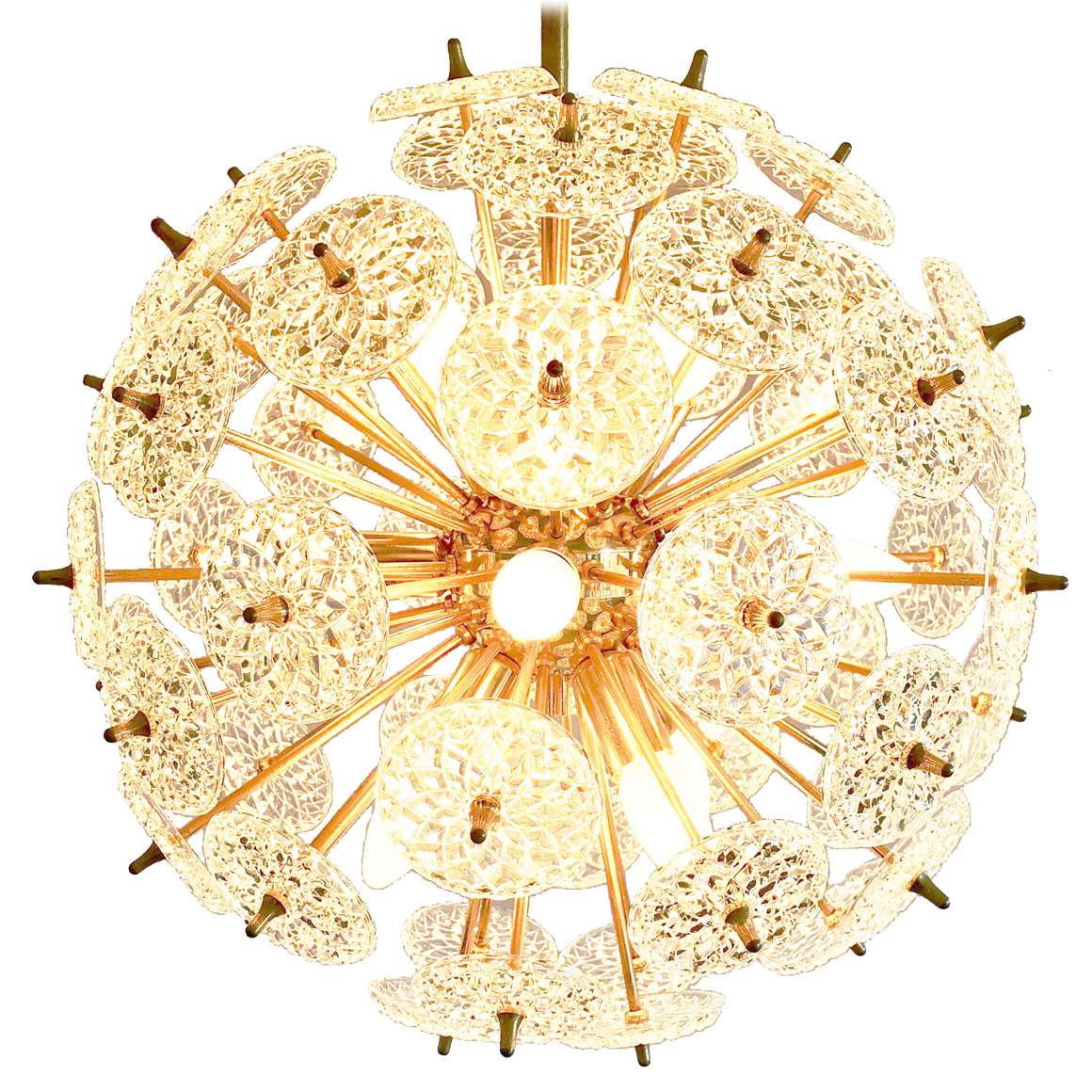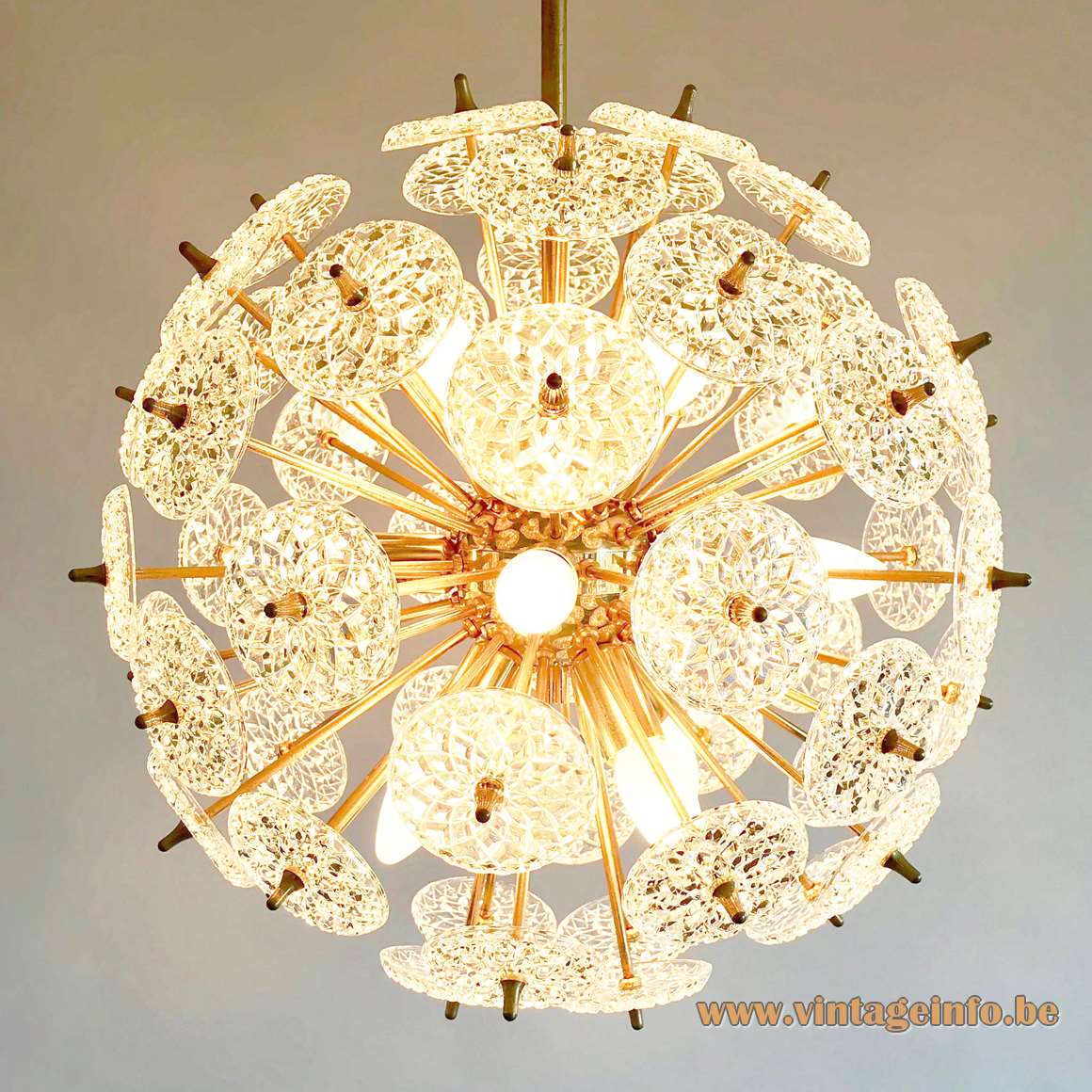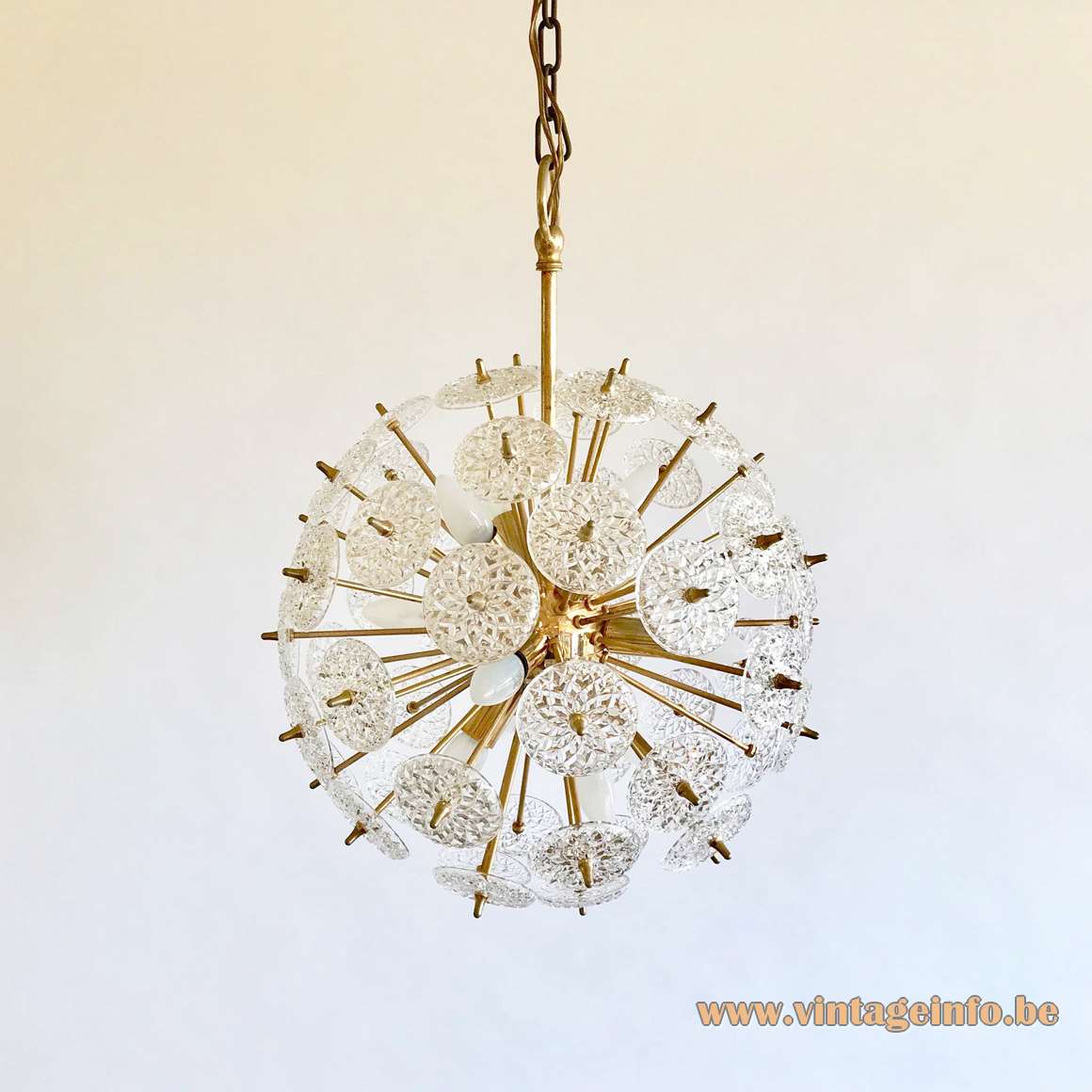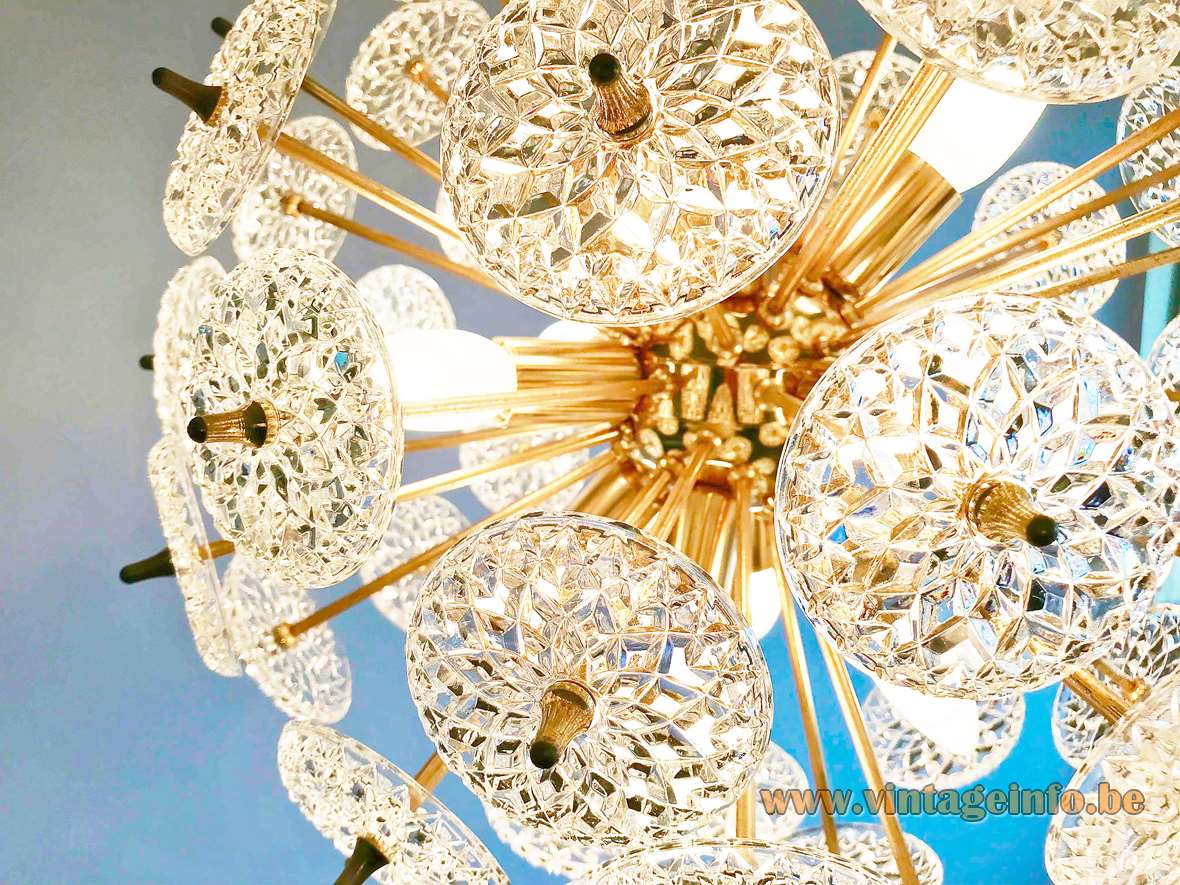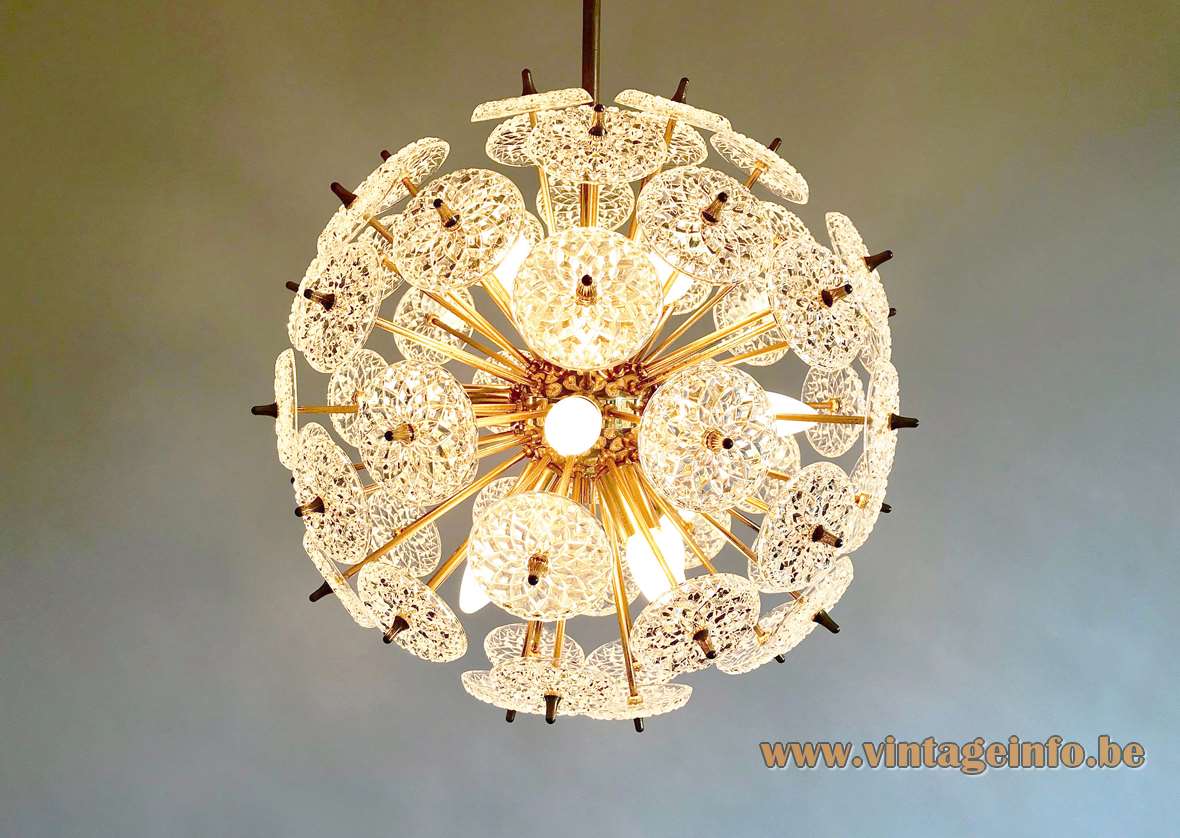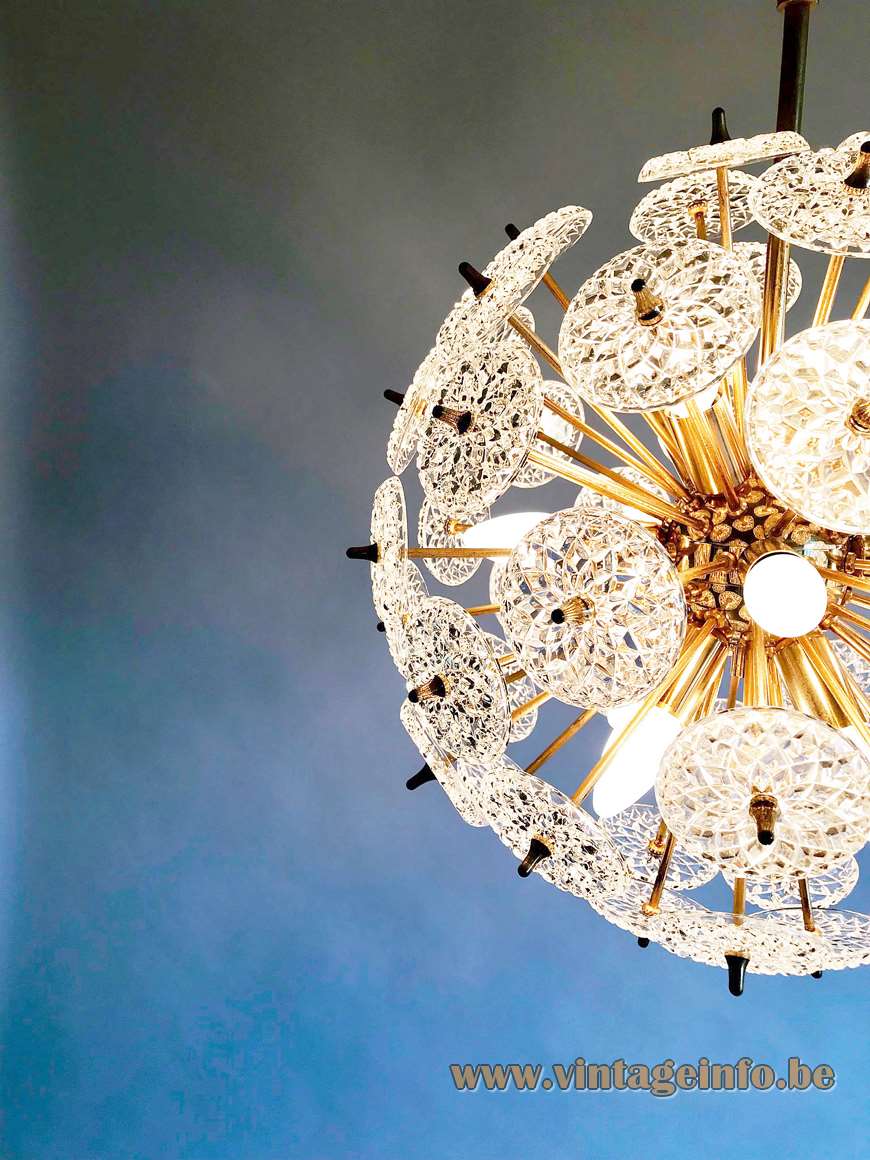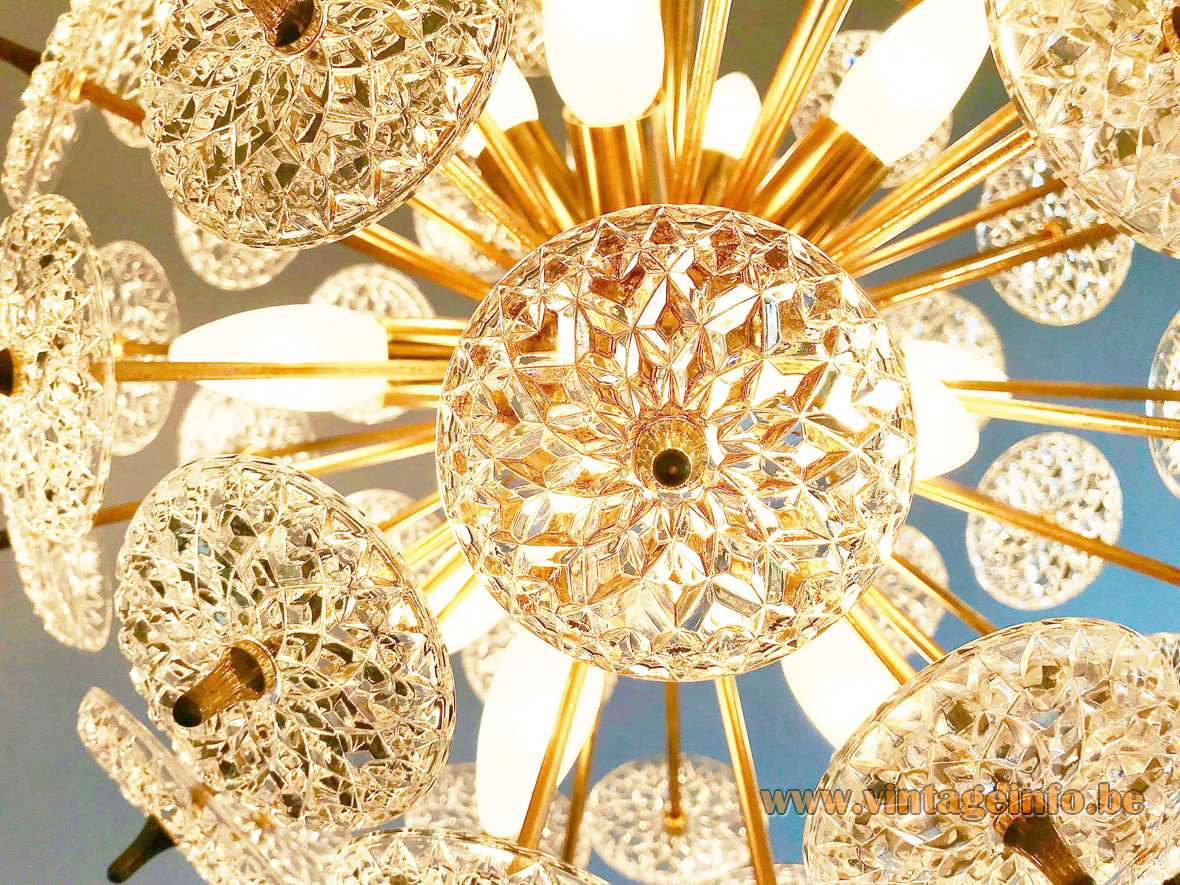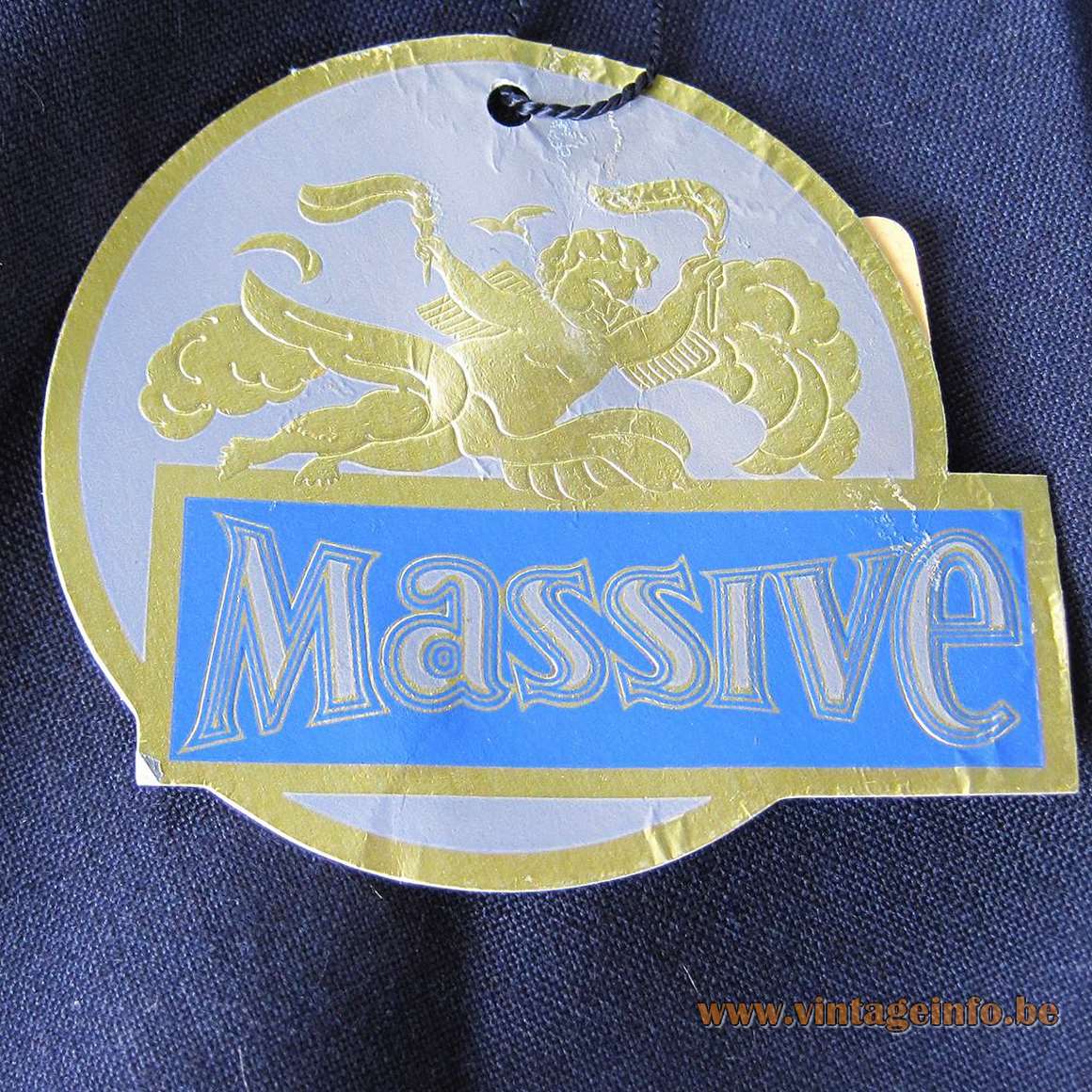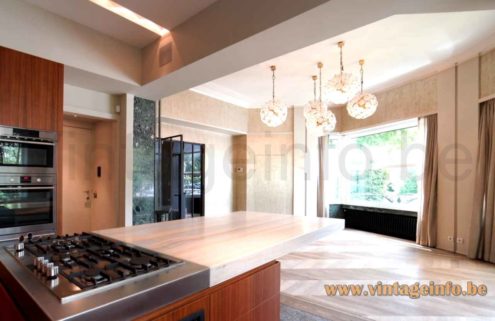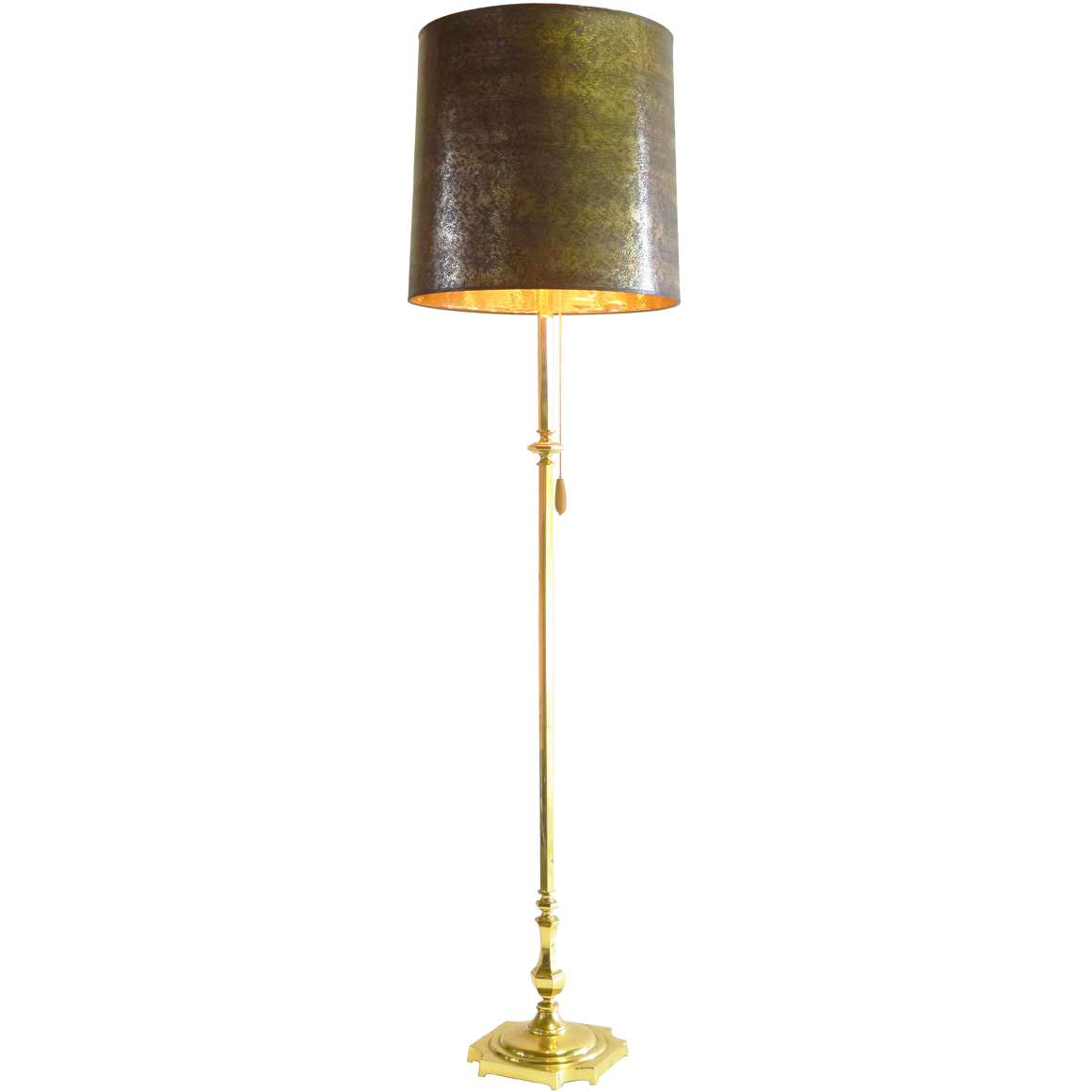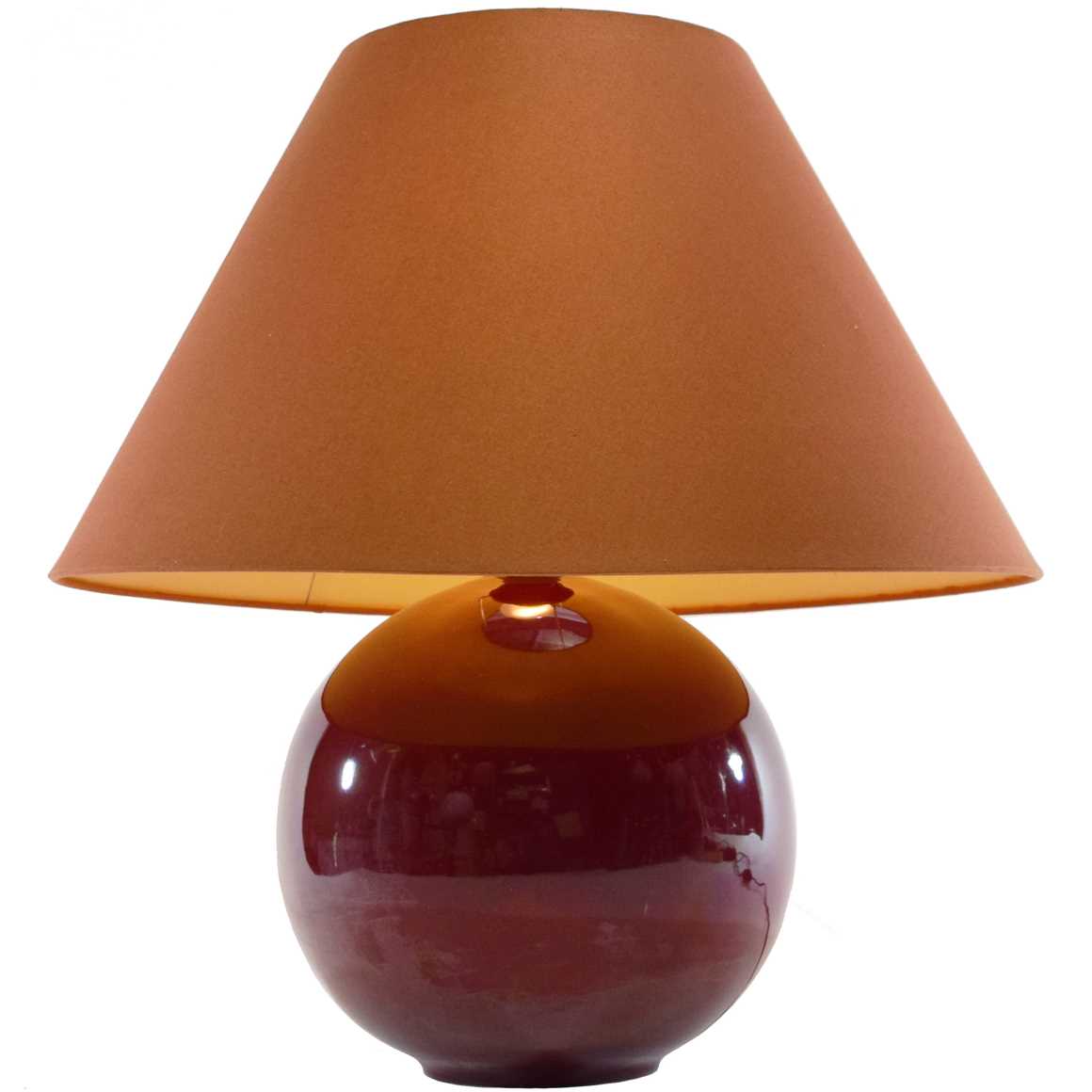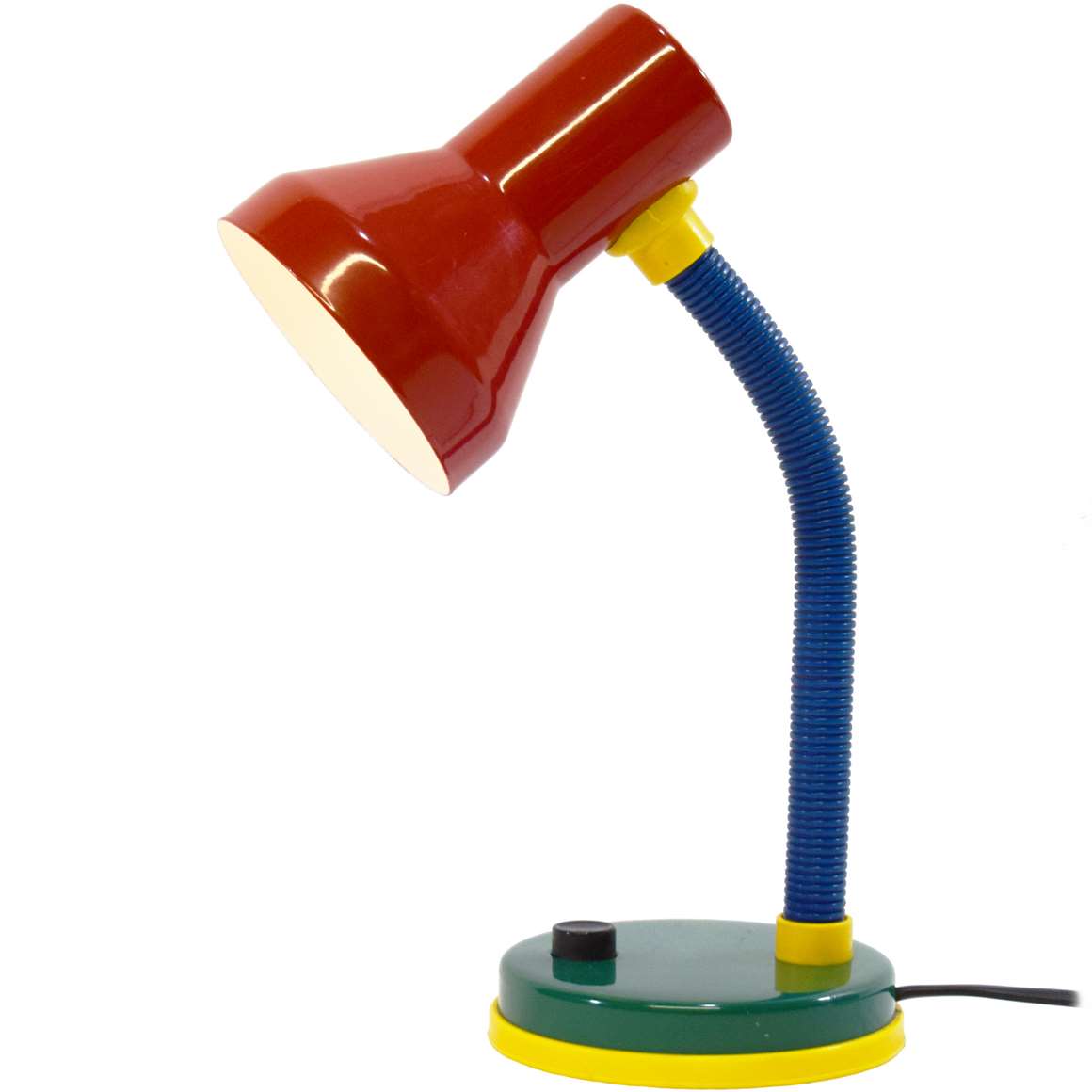Val Saint Lambert Sputnik Chandelier
The difference between the S.A. Boulanger and the Massive canopy.
S.A. Boulanger
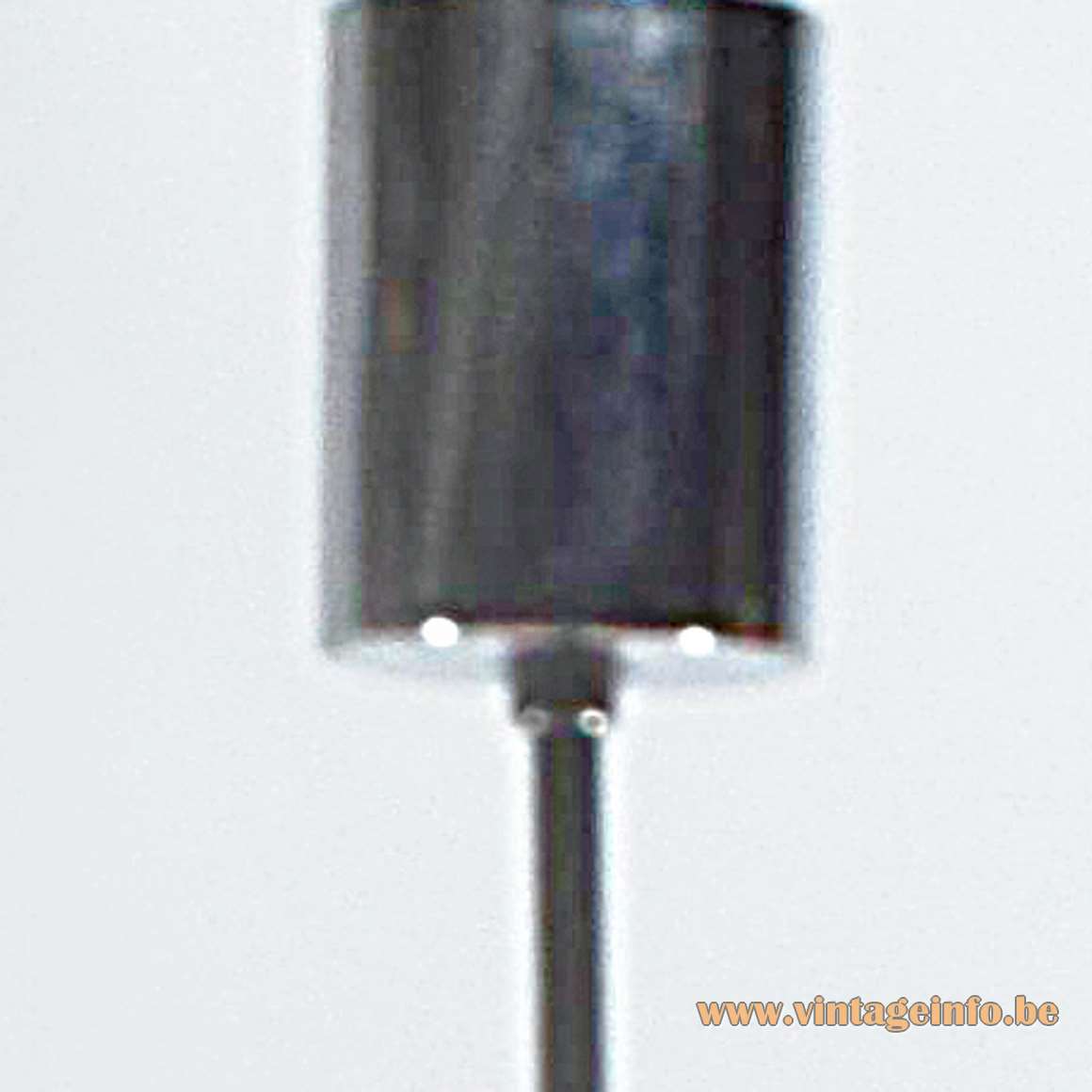
Massive
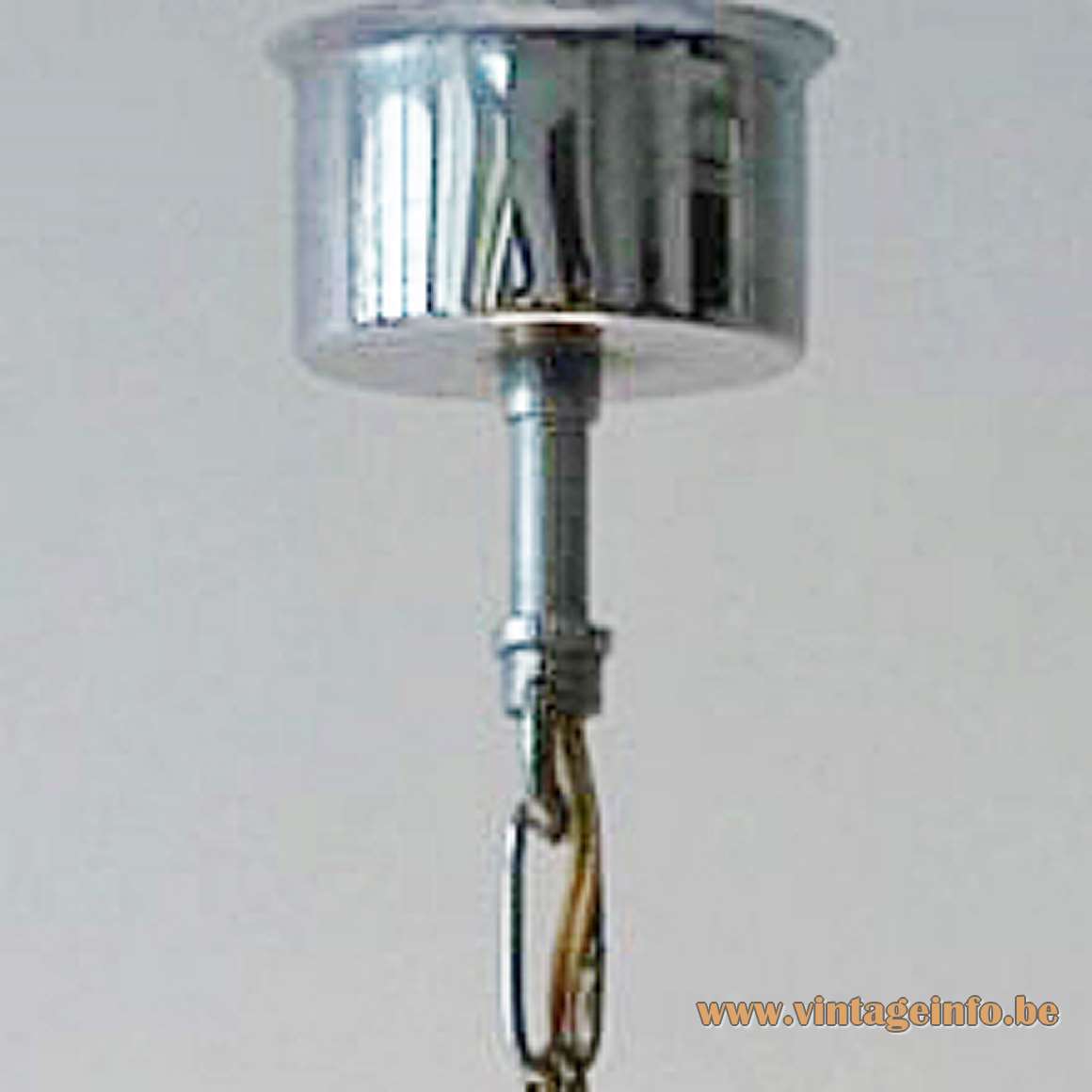
Val Saint Lambert
Val Saint Lambert is a crystal and glass factory in the Belgian city of Seraing, southwest of Liège, which produces decorative glass, glass and crystal arts and crafts. The factory is located in the abbey of Val Saint Lambert, the former Cistercian abbey of Saint Lambert. In 1826 the founders of the crystal factory settled in the favorable site, due to the large buildings available, the proximity of coal and the possibility of transport across the river Meuse. Today Val-Saint-Lambert is present in more than forty countries. One can visit the factory and see glass blowers at work.
Val Saint Lambert or Val St. Lambert was founded by chemist François Kemlin and polytechnic (Master of Science in Engineering) Auguste Lelièvre in 1826. François Kemlin had previously worked for the Vonêche crystal works in the Ardennes, also in Belgium. Val Saint Lambert is well known for its Art Nouveau and Art Deco glass pieces.
The earliest design of this chandelier dates back from the 1950s, when the Soviets launched their Sputnik 1 satellite into orbit (1957): the space age has begun.
Yuri Alekseyevich Gagarin (9 March 1934 – 27 March 1968) was the first human to journey into outer space, when his Vostok spacecraft completed an orbit of the Earth on 12 April 1961.
Val Saint Lambert craftsmen at work
Val Saint Lambert Sputnik Chandelier
Several Val Saint Lambert Sputnik chandeliers hung in a villa in Brussels, Belgium until the end of 2020.
Lamps In The Movies!
The Pink Panther Strikes Again (1976)
A crystal glass Sputnik chandelier, brand unknown, almost similar to this Val Saint Lambert sputnik chandelier, was used as a set decoration in the 1976 American British comedy film The Pink Panther Strikes Again. Starring Peter Sellers, Herbert Lom and Lesley-Anne Down. It was smashed in the umpteenth fight between Cato and inspector Clousseau. A table lamp is also destroyed in this scene that was reused in Trail of the Pink Panther of 1982. The film was made after the dead of Peter Sellers and contains many flashbacks.
Many thanks to Hans from Objeta for the beautiful pictures.
Many thanks to Eric of Val Saint Lambert for his enlightening information about these lamps.
Val Saint Lambert Sputnik Chandelier
Materials: Gilded brass rods and ornamental nuts. Gilded metal globe in the middle. Floral cut crystal discs. Metal rod, chain and canopy. 12 Bakelite E14 sockets.
Chain Length: 60 cm / 23.62”
Height: ∅ 45 cm / 17.71”
Width: ∅ 45 m / 17.71”
Electricity: 12 bulbs E14, 12 x 40 watt maximum, 110/220 volt.
Any type of light bulb can be used, not a specific one preferred.
Period: 1950s – 1970s – Mid-Century modern.
Designer: To be appraised.
Manufacturer: Massive, Mortsel, Kontich and Wommelgem, Belgium. Val Saint Lambert produced the glass parts for these lamps, as confirmed by the company.
Other versions: The Val Saint Lambert sputnik chandelier was also made with a chromed metal (iron) frame. Made in different sizes. Two types of discs: round or flat discs. Hanging on a rod or chain. Wall lamps and flush mounts also exists. Also made in brass plated iron.
Also the other Belgian company S.A. Boulanger sold these lamps. But with slightly different parts. What is most striking is a completely different canopy, as you can see on the left. The Massive label hung on a string, the S.A. Boulanger label is glued inside the canopy, but is often gone (see below).
Designed in the style of the chandeliers Emil Stejnar created for Beleuchtungskörperfabrik und Beleuchtungsglashütten (lighting equipment factory and lighting glassworks) Rupert Nikoll from Austria. But Emil Stejnar has got nothing to do with these chandeliers.
S.A. Boulanger
S.A. Boulanger was founded in Anderlecht, Belgium in 1945. The company is famous for the large amount of lights it produced that were designed by Gaetano Sciolari. At some point in the 1980s the company changed their name in Les Ateliers Boulanger NV.
It has long been thought that they were two different companies, but that is because a trader from Liège, Belgium persisted that the lamps came from Herstal, near Liège.
In 1996 the company had 11 employees. The firm moved in 1998 to the Martelarenlaan 155 in 3010 Kessel-Lo, near Leuven. In the period 1995 – 2001 Jean-Philippe Spalart was the CEO. He did a feasibility study for the transfer of the company to China, Eastern Europe and Africa. Relocation of the manufacture in Zimbabwe.
Boulanger was specialised in metal processing and manufacturers high-end lamps and lighting fixtures. Les Ateliers Boulanger ended business in 2006.
Massive & Boulanger
Massive sold several Boulanger models over the years. The only difference is the typical Massive canopy/ceiling cap and some other parts. As you can see with this lamp.
Old text from the 1990s
“Boulanger sells mainly in the high-end lighting markets in Belgium, Germany and Luxembourg. The growing sales in the US and in South Africa are of growing importance to the company. Due to the highly competitive market, having product with a high added value is very important. The intelligent lamp is an important advantage, compared to our competitors, and will increase our market share in an important way.
The most important local competitors are Massive, a Belgian company, market leader in Europe (turnover of 100 MEUR), Deknudt at Deerlijk (turnover 2.5 MEUR) and some 10 other Belgian competitors of its own size. There is important competition from southern European and Asian competitors. The market share of Boulanger is only a few percent of the share of the Belgian companies. It is a small company with a turnover of about 300 k EURO.”
“Most Boulanger lamps are low voltage and halogen lamps (220V up to 300W or 12V up to 50W).
The products are sold to retail shops. In Belgium, about 300 retail shops sell its products. There are around 40 retail shops abroad: Luxembourg, Germany, France and South Africa.”
Massive
Origins and Early Growth (1926–1970s)
Massive started in 1926, when Pieter-Jozef De Jaeck founded a bronze foundry in Wilrijk, near Antwerp, Belgium. Initially, the company crafted traditional bronze items such as candlesticks, crucifixes, and chandeliers in-house using established casting methods.
However, as the market evolved during the 1930s and 1940s, Massive quickly adapted to meet changing consumer needs. Therefore, the company gradually introduced more functional lighting products for households. After World War II, electric lighting became more popular across Europe.
Consequently, Massive began combining classic design with modern electrical technology. This strategic shift enabled the brand to reach new customers and grow steadily.
By the 1950s, Massive had earned a solid reputation across Belgium. Its lighting fixtures – often inspired by mid-century trends – were both affordable and practical. Moreover, they were widely available in hardware and furniture stores. As a result, they became a staple in many homes.
In the 1960s, Eddy De Jaeck, the founder’s son, joined the company. He introduced semi-industrial production techniques and optimized logistics. As a result, Massive shifted from a craft-based workshop to a mass production business. This major change laid the groundwork for international expansion.
Design Approach and Product Strategy
Massive became known for producing lighting in the style of more exclusive brands. While they didn’t make direct copies, many of their designs were clearly “inspired” by well-known models. Nevertheless, the company also released some original highlights that stood out in their own right.
In addition to their own production, Massive distributed a significant number of lamps made by other manufacturers. This strategy was not unusual at the time. Many lighting companies across Europe followed the same practice to broaden their product range and appeal to a wider market.
International Expansion and Market Leadership (1970s–2000s)
During the 1970s, Massive expanded rapidly. With Eddy De Jaeck at the helm, and later his sons Piet and Jan De Jaeck, the company grew into a multinational enterprise. To stay affordable and increase volume, Massive moved production to Eastern Europe. Later, it extended manufacturing to China. This deliberate strategy helped the brand stay competitive in a changing market.
By the 1980s, Massive had become one of the top lighting brands in Europe. Its catalog included thousands of options for both indoor and outdoor use. Furthermore, the brand balanced style, affordability, and reliability. Because of this, it gained popularity in both Western and Eastern Europe.
In the Netherlands, Massive began operations in 1962. In addition, the company opened Massive Gorinchem in 1969. This location served as the Dutch headquarters for more than 40 years. Eventually, in late 2012, it relocated to Eindhoven.
Ownership Changes and the Philips Takeover (2002–2010)
In 2002, the De Jaeck family sold Massive to CVC Capital Partners for about €250 million. This move transformed the company into part of the new group, Partners in Lighting International (PLI).
Over the next years, PLI expanded quickly. For example, in 2005, the group acquired Modular Lighting Instruments. Then, in 2006, it added Trio Leuchten from Germany. As a result, PLI marketed over 10,000 products under brands like Massive, Lirio, Trio, Aqua, and Cucina.
The company grew further by employing about 5,000 people and operating in more than 70 countries. In 2007, Royal Philips Electronics announced plans to acquire PLI. The deal closed in 2008, which strengthened Philips ‘ position in the European home lighting market.
Soon afterward, Philips rebranded all Massive stores in Belgium as Light Gallery. By 2014, the Massive name had vanished from packaging and store displays alike.
The End of an Era and the Move to Signify (2010–2024)
After the acquisition, Massive ‘s visibility declined steadily. In 2016, Philips Lighting became a separate, publicly traded company. Then, in 2018, the company rebranded as Signify. This new identity marked a fresh focus on smart and connected lighting.
Eventually, in April 2024, Signify shut down the Light Gallery website and redirected all content to its main platform. Although the Massive name no longer appears in stores, its legacy lives on. Millions of homes throughout Europe still feature its recognizable and timeless lighting designs.
Links (external links open in a new window)
Massive – Wikipedia (in Dutch)
The complete history of the Philips company
History of the Val Saint Lambert company
Cristal Discovery – website of the Val Saint Lambert museum – Discover the museum with Google Street View!
Cristal Park Val Saint Lambert
Personal website about Val Saint Lambert (in French) – research about old pieces.
Collection Luxval
The Pink Panther Strikes Again (1976) – Wikipedia
The Pink Panther Strikes Again (1976) – IMDb
Trail of the Pink Panther (1982) – Wikipedia
Trail of the Pink Panther (1982) – IMDb
Vintageinfo
Rosette crystal glass chandelier
